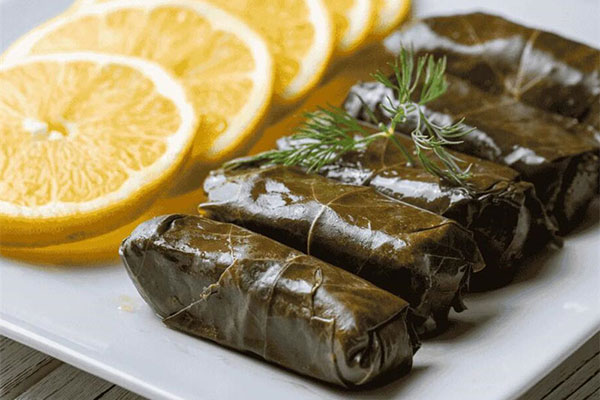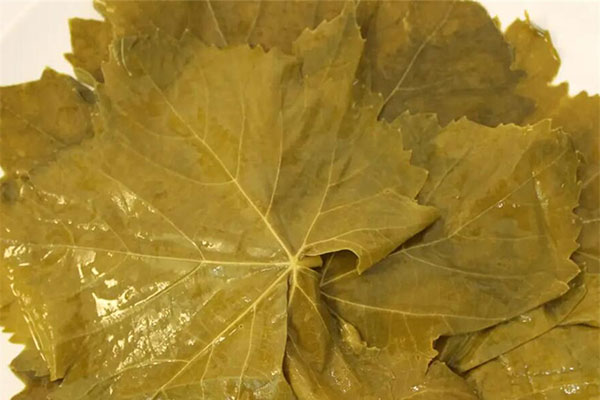Home » pickled grape leaves

What Is Pickled Grape Leaves?
- Other name: Grape leaves, vine leaves, brined grape leaves
- CAS No.: 84929-27-1
- HS Code: 2005999100
- Appearance: Green leaves
Pickled grape leaves are a processed food product made by treating fresh grape leaves with salt and an acidic solution to achieve long-term preservation. It’s not a snack to be eaten directly, but a culinary ingredient with a specific purpose, especially indispensable in Mediterranean, Middle Eastern, and Balkan cuisines.





Packaging of Grape Leaves for Sale in Chemate
| Packaging | Drums/ per 20’ft | MTS PER 20’ft(kg) |
| 370kg/drum | 77 | 28490KGs |
| 380kg/drum | 75 | 28500KGs |
| 390kg/drum | 73 | 28470KGs |
| 20.5kg/drum | 1280 (with pallet) | 26240KGs |
Would Like The Quotation
Leave more about your requirements, such as, tech grade or food grade, quantity, package, country, etc.
Why pickled grape leaves?
Fresh grape leaves have an extremely short shelf life, being at their most tender only in late spring and early summer. To enjoy this unique flavor year-round, the pickling method was invented.
Long-term preservation. The high concentration of salt and the acidic environment effectively inhibit bacterial growth, allowing the grape leaves to be preserved for a long time.
Enhanced food flavor. The pickling process softens the leaf fibers, making them exceptionally pliable and more suitable for wrapping fillings without breaking. At the same time, salting imparts a unique salty and savory flavor, becoming a cornerstone of the flavor profile in dishes.
More convenient to use. A jar of homemade pickled grape leaves is a kitchen treasure, readily available, with consistent quality, making exotic delicacies easily accessible.
What are main Uses of Grape Leaves for Pickling in Food
Grape leaves are the most central and well-known use for food, their pliable texture making them ideal as “edible wrapping paper.”
1.Stuffed grape leaves
This is the most representative application of pickled grape leaves, known by different names in different cultures, such as Dolmas or Dolmades in Greece, and Warak Enab in the Arab world.
The two common fillings of stuffed grape leaves:
Meat Fillings: Typically made with rice mixed with herbs (such as dill, mint, and parsley) and minced lamb or beef.
Vegetarian Fillings: More common, made with rice, pine nuts, raisins, onions, and a generous amount of fresh herbs, seasoned with olive oil and black pepper.
Cooking Method
Tightly roll the raw rice filling in the vine leaves and place them at the bottom of a pot. Drizzle with olive oil and lemon juice, add water or broth, and simmer until the rice is fully cooked and has absorbed the broth. The finished product is soft and sticky, with a tangy and savory flavor, often served as an appetizer or main course.
2. A “Cover” for Baked Foods
Utilize the wrapping properties of grape leaves to wrap fish, chicken, or goat cheese when baking.
Functions:
Locking in moisture: Prevents meat from drying out during baking, keeping it tender.
Enhancing flavor: The salty and herbal aroma of the grape leaves permeates the food, adding a unique Mediterranean flavor.
Preventing burning: The leaves themselves provide some protection.
3. As a Flavoring Liner
Usage: When steaming seafood, meat, or vegetables, place a few soaked and desalted pickled grape leaves at the bottom of the steamer.
Functions: Under the steam, the fragrance of the leaves slowly rises, permeating the food above, adding flavor, and also preventing food from sticking to the steamer.
What are the advantages of pickled grape leaves?
Breaking seasonal limitations, usable year-round. Fresh grape leaves have a very short shelf life, but pickling techniques have successfully transformed this seasonal ingredient into a kitchen staple, allowing people to make delicacies in any season.
More convenience and easy to obtain. Available in supermarkets or online stores, eliminating the need to find and pick pesticide-free grape leaves yourself.
Ready-to-use. Compared to fresh leaves, it eliminates the steps of picking, sorting, and initial processing. Simply open the package and use.
Tough and resilient. The salting and blanching processes soften the leaf fibers, greatly increasing their resilience. They are less likely to tear when wrapping fillings.
Stable quality and easy storage. Commercially available pickled grape leaves undergo rigorous sterilization and sealing, resulting in a long shelf life before opening. They are also relatively uniform in size and thickness, ensuring consistent quality. Homemade pickled grape leaves can be stored for months under refrigeration.
Unique Flavor. The pickling process imparts a unique salty, savory, and slightly acidic flavor base to the grape leaves, which is an integral part of the flavor profile of many Mediterranean dishes, providing direct flavor support.
Disadvantages of Pickled Vine Leaves
Desalting Pre-treatment. This is the most crucial and unavoidable step when using pickled vine leaves. Using them directly would result in dishes with excessively high salt content that are inedible.
Nutritional Loss. During blanching and salting, some water-soluble vitamins are inevitably lost. Compared to fresh grape leaves, their nutritional value, especially the content of certain trace elements, will be lower.
Flavor and Texture Loss. Pickled leaves lose some of the fresh, herbaceous aroma characteristic of fresh grape leaves. While still tender, they lose some of their crispness and freshness.
High Sodium Content. Even after soaking and desalting, pickled grape leaves still have a relatively high sodium content.
Additives Contained. Commercially available pickled grape leaves may contain citric acid or other permitted preservatives to stabilize quality and extend shelf life. While meeting safety standards, those who prefer purely natural ingredients may be concerned.
How to Use Pickled Grape Leaves
The pickled grape leaves must be desalted. Brined grape leaves have an extremely high salt content for long-term preservation. If used directly, dishes will be too salty to eat. Therefore, the first and most important step before use is to remove excess salt.
- Taking and Separating: Take out the required number of grape leaf rolls from the jar or bag. They are usually tightly wrapped together, so carefully separate them one by one to avoid tearing.
- Thoroughly Rinse: Place each grape leaf under running cold water and gently rub both sides with your fingers to wash away the surface salt and marinade.
- Soaking: Place all the rinsed grape leaves in a large bowl or basin and add enough cold or warm water to cover them. Soak for at least 30 minutes, ideally for 1 hour. Change the water 1-2 times during this time. You can taste the water to check the saltiness. It should taste only slightly salty.
- Draining and Drying:Remove the soaked grape leaves and gently pat them dry with kitchen paper towels or a clean cloth. This will make wrapping the filling easier and prevent excess water from diluting the flavor of the filling.
How to Use Pickled Grape Leaves
1. What kind of grape leaves are best?
Size: Palm-sized or slightly larger is ideal for easy wrapping.
Shape: Whole, undamaged leaves.
Condition: Choose leaves from grapevines free from pests, diseases, and pesticides.
2. Does it need to be pickled immediately after harvesting?
Yes, it’s best to process them within 24 hours of harvesting to maintain their optimal freshness and flavor.
3. Why is blanching necessary before pickling?
Sterilization: Removes bacteria from the leaf surface.
Softening the leaves: Makes the leaves more flexible and less likely to break during wrapping.
Removing the astringency: Removes the astringency of the leaves, improving their taste.
Maintaining color: Fix chlorophyll, preventing yellowing during pickling.
4. How to pickle grape leaves at home?
The most classic method is to use brine.
Stack 5-10 completely cooled and drained grape leaves in a stack. Roll the leaves into tight small rolls and place them in a clean, oil-free glass jar. Pour in completely cooled brine, ensuring all leaves are submerged and no part is exposed to air.
Drizzle with 1-2 tablespoons of lemon juice or white vinegar.
Seal the jar tightly and let it sit at room temperature for 24 hours, then refrigerate.
5. Can I use plastic containers for pickling grape leaves?
Glass jars are best. Glass is chemically stable and will not react with the brine. Plastic containers may absorb flavors and may not be suitable for long-term storage of acidic or salty foods.
6. How long after pickling can I eat it?
It needs to pickle for at least 3-4 weeks for the flavor to develop. They can be stored for up to a year.
7. Do pickled grape leaves taste different from fresh leaves?
Yes. Pickled grape leaves have a unique, mildly acidic and salty flavor, a classic taste in many Mediterranean dishes. Fresh leaves have a fresher, more vegetal aroma.
- Email: sales@chemategroup.com
- Tel: 0086-371-60921621
- Whatsapp: +86 18624832876
- Wechat: +86 18624832876
- ADD: NO.80 PUHUI ROAD,ZHENGZHOU CITY, HENAN PROVINCE, CHINA
